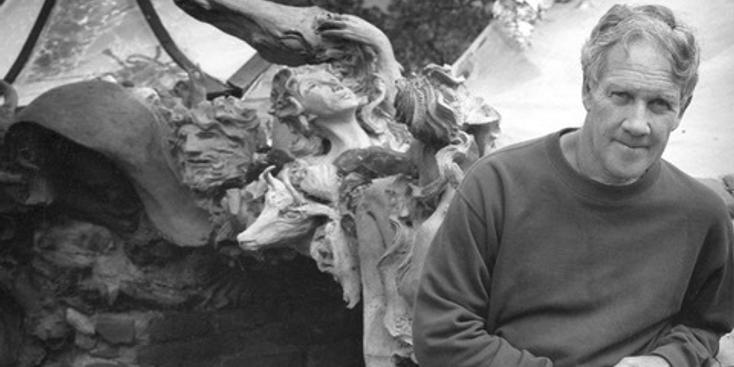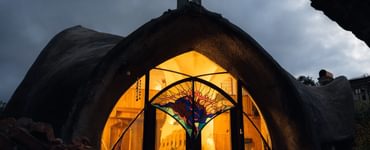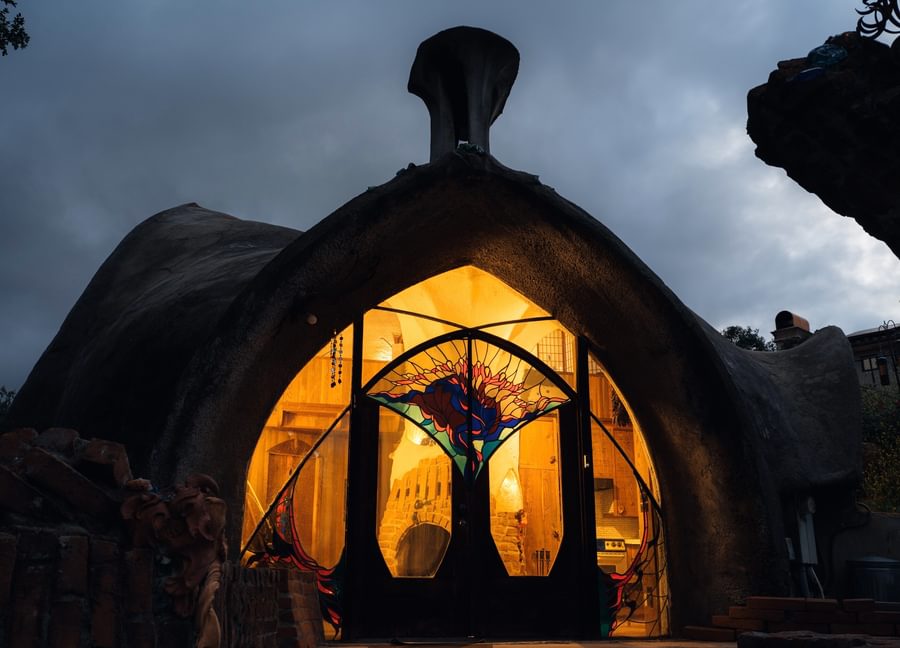James Hubbell
1931 - 2024
A reverence for nature remains the basis of James Hubbell’s singular career, one that seamlessly integrates art, craft and architecture. Hubbell studied sculpture at Cranbrook Academy of Art and often worked with wood, iron and stained glass in a contemporary architectural context alongside Sim Bruce Richards.

James T. Hubbell is well known for his sculptural home in Santa Ysabel as well as parks, schools and other environments that bring art into the realm of everyday human experience. Mr. Hubbell was born on October 23, 1931 in Mineola, New York to Julia Jones and James Hubbell Sr. Akin to the experiences of his brother Bert and sister Ann, having attended thirteen schools by the time of his high school graduation, James finished at Choate, in Connecticut (in 1950) at a time the young man invested himself in hitch-hiking across the states. Shortly after graduation, he and others toured Africa and Europe before returning to the US (in 1951) to enroll in the Whitney Art School. By 1952, he was drafted into the US Army and initially stationed at Fort Ord (in Monterey), Naval Air Station Alameda and Camp Stoneman (in Sacramento). Stationed in Taegu, Hubbell was assigned a variety of graphic arts projects through the end of the Korean War.
Shortly after James returned home, in 1954, he left for Cranbrook. During his two years (1954-56) at the Bloomfield Hills, Michigan campus he spent time in Europe witnessing the work of Antoni Guadi, Henri Matisse, and Michelangelo among others. Returning to San Diego County, the young artist established a studio on his mother's property in Rancho Santa Fe.
While attending Questaven, his army buddy Jim Hulbert introduced James to Anne Stewart in 1953. They two married and purchased property near Julian in 1958.
James' mother, now Julia Larrea, recognized her son's labor-intensive work inwrought iron and stained glass in a contemporary architectural context, and introduced him to architect Sim Bruce Richards. Following their first collaboration, in the mid-1950s on a stained glass project for a Richards-designed home in Del Mar, the duo initiated a long history of collaboration. Hubbell's work integrated into Richards' architecture would prove mutually beneficial (not to mention clients' years of enjoyment of the results). Following his work with Richards, Hubbell engaged in relationships with others like Lloyd Ruocco, Martha Longenecker
During the 1960s and '70s Hubbell’s work was included in the prestigious series of California Design exhibitions at the Pasadena Art Museum and the Arts of Southern California series at the Long Beach Museum of Art, as well as at the Museum of Contemporary Crafts in New York. His forged iron work was featured in Craft Horizons magazine in the 1970 article “The Contemporary Blacksmith.” James Hubbell was also one of the artists profiled in the final California Design publication from 1977, Craftsman Lifestyle: The Gentle Revolution.
Interview Excerpt
James Hubbell: It doesn't fit either. I think you're right about the art historical thing. There's a painter who used to paint black on black and white on white. I remember in school we used to talk about him. This was back in the '50s. About twenty or twenty-five years later I read that this guy had finally become really important. And the reason was that there were four of five other people doing it. He'd become a movement. The writers and critics are trained to see things that way, not in terms of individuals, but movements. My problem more particularly is that when I went to Whitney Art School in Connecticut, I had this great teacher. In about a six month time, he gave you the whole world. We went through every style, every method. We stared with four straight lines. When I got through I realized I could do whatever I wanted. It was all part of the language of what I could do. That's very confusing to the artworld. This teacher also said, "If you want to be famous, find something that is easy to recognize. Every time you paint a picture, put red dots around it. That way anyone can walk in and from the other side of the gallery can say, 'oh that's a so and so'."
RW: Who was this teacher?
James Hubbell: Lou York. I think he taught at Yale for a long time. He was just a really great teacher. But in other ways, it's given me a huge amount of freedom, so I wouldn't trade it for anything.
RW: You mentioned someone else who made a big difference in your life.
James Hubbell: Sim Bruce Richards. He'd worked with Frank Lloyd Wright in the '30s. When I was about 21, I did my first job with him on one of his homes. Over the next 25 years I probably did something in every one of his buildings. Windows, doors, columns, pools.
RW: You said it was unusual for an architect to hire an artist.
James Hubbell: Yes. I don't know why. I think architects think that artists are just another problem. They bring in stuff that isn't standard. In Berkeley I think, the architecture department is in the science department. It's not in the humanities where it should be.
RW: And people don't know how to categorize you, I suppose. I first heard of you as "an architect." You've pointed out that you cross categories, and that's an interesting thing in itself.
James Hubbell: I'm not even an architect.
Partial List of Projects
All Souls Episcopal Church (windows)
Point Loma
California Western University
Rohr Hall sculpture
Davidson Residence (1972)
1025 Alpine Blvd, Alpine
Greenery, The (1972)
4475 Mission Boulevard, Pacific Beach
*Demolished
Hubbell, James & Anne Residence & Studios (1958 – 1965 + later additions)
930 Orchard Lane, Santa Ynez
Point Loma Nazarene (details) (1962)
Point Loma
*Formerly California Western University
Rainbow Hill House (1991)
643 Oak Land Road, Julian
St. Andrews Episcopal Church (windows) (1960)
Pacific Beach
St. Catherine Laboure Catholic Church (sculpture) (1965)
4124 Mt Abraham Ave, San Diego
St. Leo's Catholic Church (sculpture) (1965)
936 Genevieve Street, Solana Beach
Sunshine Elementary Playground (1962)
4133 Mt. Albertine Avenue, San Diego
Triton Restaurant
Cardiff By The Sea
University Christian Church (windows) (1962)
Vint, Vincent J. & Tanya Residence (1964)
187 Nob, Del Mar
Vint, Vincent J. House (1983)
3877 Arroyo Sorrento Road Del Mar
Wishing Well Hotel (1962)
Rancho Santa Fe
*With Sim Bruce Richards for Hubbell's mother Julia Larrea

FOR SALE: Davidson Residence by James Hubbell and Robert Thiele (1979)
FOR SALE: Davidson Residence by James Hubbell and Robert Thiele

The Davidson Residence (1975-79) was designed by sculptor James Hubbell in partnership with architect Robert W. Thiele as Earth Form Builder. The original owners recall starting the project as early as 1970-72 in a multi-year span of time they built it with their own hands. Shortly after completion, this home (one of only a handful of structures to see the artist’s vision fully realized) was initially published in the book ”From the Earth Up: The Art and Vision of James Hubbell” (McGraw-Hill, 1979) by Otto.B. Rigan. Singular in its vision and execution, the home is as much a respite from urbanity as a chapel to the (2/3rds of an acre) surrounding native flora and seasonal stream.
Between 1970-27, the Davidson family embarked on a multi-year endeavor of building a home for themselves. While that sounds fairly routine, what followed was anything but. Following their purchase of 2/3rds of an acre along Old Highway 80 (now Alpine Boulevard) Carl and Marilyn Davidson connected with multimedia artist James T. Hubbell (1931-2024) to develop a sculpture the couple, and their four daughters, could reside within.
Working together under the banner Earth Form Builder, Hubbell and architect Robert W. Thiele created a set of plans for an oval footprint dome-like sculpted structure of steel, rebar, wire mesh and gunnite. Earth Form Builder went on to build only one other home in Poway.
Following the planning and permitting, in 1975, the family embarked on a nearly 4-year journey of constructing the home as they raised the funds, and garnered the support of friends and a handful of professionals to hand-build a home from the earth up.
Shortly after completion photographs of the home were included in Otto B. Rigan’s book From the Earth Up: The Art and Vision (McGraw-Hill, 1979). These black and white photos detail the drama of the finished product as well as images of the home during construction including a fantastic image of two men wielding a gunnite hose spraying the concrete material onto the steel cage structure.
In 2000, the Davidsons sold their visionary residence to Susan Cassidy who in turn sold it to Walter and Susan Allen (in 2005). The current owner, Charles “Chuck” Samples purchased the home in 2013 and has served as its caretaker ever since.
With steel ribs (heated and bent by hand on site) radiating from the central fireplace structure, the dome-like residence features significant glass openings in-filled with Hubbell’s organic, Art Nouveau stylings in brick and mosaic tile, handmade fixtures, twisting metal railings and light fixtures, as well as expansive stained glass windows.
Today, the Davidson Residence stands apart from most private residences. Within the gunnite and steel shell, is approximately 800 square feet of living space with the bedrooms, bathroom, kitchen and living area encircling the central fireplace. Beyond the redwood cabinetry and stairs, most every surface is brought to life through a richly textural and colorful palette of stone, tile, copper, steel, glass.
Standing as one of only a handful of structures to see the artist’s vision fully realized (and still intact) the home symbolizes a bygone era while remaining timeless. The surrounding acreage of native plant species draw visitors to the lower portion of the land - the idyllic Alpine Stream which creates the property’s southern boundary.
Offered at $775,000, the Davidson Residence (1975-79) stands as a beacon of ‘70s idealism through a prism of rare artist-driven hand-built residences. With the seller intent on finding its next caretaker, Agents of Architecture, is honored to help pass the baton.
Architect
James Hubbell
Can't Miss Modern!
Sign up for our newsletter and get exclusive content from Modern San Diego.